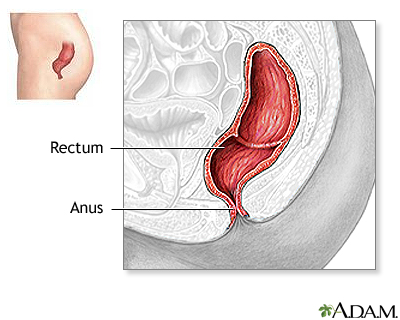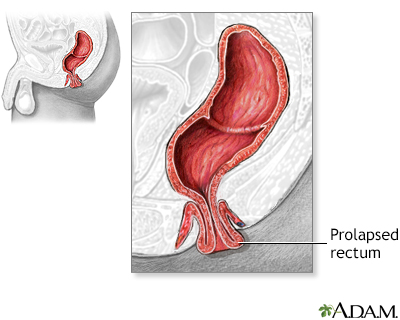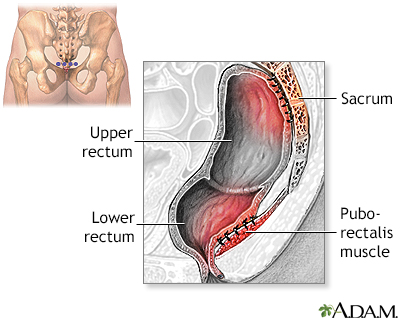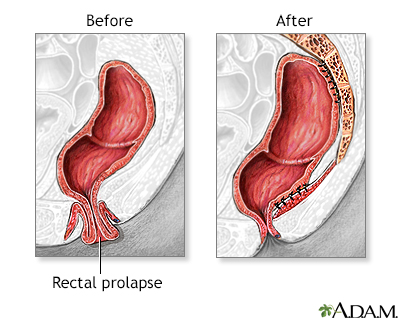Health exams for: #AGEGROUP#
The following exams, tests, and procedures are recommended for #AGEGROUPLOWER#.#FEMALETEXT#
Select a link from the list below to learn how and why each test is performed, as well how to prepare for it.

The following exams, tests, and procedures are recommended for #AGEGROUPLOWER#.#FEMALETEXT#
Select a link from the list below to learn how and why each test is performed, as well how to prepare for it.




The rectum is the final portion of the large intestine. It empties stool from the body through the anus. The rectum is anchored in position by ligaments. When these ligaments weaken, the rectum can move out of its normal position, downward, and pass through the anus. This is called rectal prolapse.
The rectum is the final portion of the large intestine. It empties stool from the body through the anus. The rectum is anchored in position by ligame...
Rectal prolapse may be partial, involving only the mucosa or complete, involving the entire wall of the rectum. Children with myelomeningocele and bladder exstrophy as well as children with cystic fibrosis are particularly at risk. Rarely it can be caused by acute diarrhea or straining while passing constipated stool. Most cases of prolapse do not require surgical correction. Infant prolapse often disappears without intervention. Rectal prolapse repair is advised for a continued rectal prolapse that does not clear up or is unresponsive to treatment of an underlying condition.
Rectal prolapse may be partial, involving only the mucosa or complete, involving the entire wall of the rectum. Children with myelomeningocele and bl...
General anesthesia is used and the patient is deep asleep and pain-free. The surgeon makes an incision near the base of the spinal column (coccyx), and identifies the pelvic floor (perineal) support structures. The lower rectum is sutured to the puborectalis muscle for support, while the upper part of the rectum is pulled up and sutured to the sacrum.
General anesthesia is used and the patient is deep asleep and pain-free. The surgeon makes an incision near the base of the spinal column (coccyx), a...
The surgery is usually effective in repairing the prolapse. The long-term prognosis is excellent. Usually only 1 or 2 days of hospitalization is all that is required. Expect complete recovery within 4 weeks.
The surgery is usually effective in repairing the prolapse. The long-term prognosis is excellent. Usually only 1 or 2 days of hospitalization is all ...
Review Date: 4/20/2022
Reviewed By: Debra G. Wechter, MD, FACS, General Surgery Practice Specializing in Breast Cancer, Virginia Mason Medical Center, Seattle, WA. Also reviewed by David C. Dugdale, MD, Medical Director, Brenda Conaway, Editorial Director, and the A.D.A.M. Editorial team.



